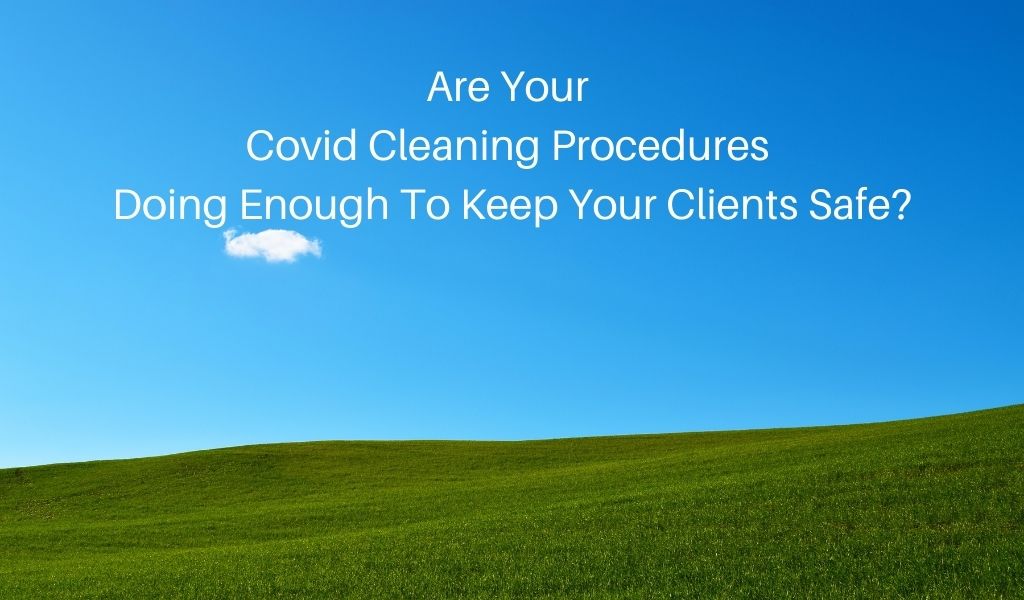Client safety is a primary concern, especially with such a harmful and contagious virus still circulating. Here’s how Covid cleaning procedures can help mitigate the risks.
As vaccines continue to be administered across the country, more and more people are returning to the workplace. That’s good news for your cleaning business—more offices to clean!—but it needs to be good news for your clients, too. They’ll want to know that your Covid cleaning procedures help keep them safe as they focus on their daily tasks. But how can you reassure them if you’re not certain yourself?
There’s a lot of information on how to properly execute Covid cleaning procedures to minimize the risk of spreading the virus. The Centers for Disease Control and Prevention (CDC), World Health Organization (WHO), the Environmental Protection Agency (EPA), and the Occupational Safety and Health Administration (OSHA) have all released guidelines that cleaning businesses can and should adhere to in order to keep both their employees and their clients safe.
In short, it might be helpful to think about your clients’ the same way you would think about the safety of your employees and even your own safety. If you apply the same protocol across the board, your Covid cleaning procedures should be as effective as possible at preventing the transmission of COVID-19. Here are some key points to think about.
Enjoy a complimentary consultation call with Janitorial Manager to see how we can help make your business shine!

Personal protective equipment (PPE)
There is perhaps nothing more effective at reducing the spread of COVID-19 than the PPE your employees wear when on the job site. At a minimum, masks and gloves should be worn properly at all times and disposed of when soiled or when an employee moves on to another room or job. Masks must cover the nose and mouth to successfully block any germs. (Note that N95 respirators offer the most protection.) Gloves should fit well and be changed often, turning them inside out when disposing of them.
Even if clients aren’t present on the worksite at the time of the cleaning, PPE worn by your employees still helps to protect the clients who will inhabit the worksite later since the coronavirus can linger on surfaces and in the air for long enough to pose a threat. Remember, even if an employee doesn’t exhibit signs of COVID-19, they may still carry the virus, so it’s important to assume as much and use PPE accordingly.
Focus on high-touch areas
Most of us never realized exactly how many high-touch surfaces there are in any given workplace until the arrival of COVID-19. Since then, most Covid cleaning procedures call for special attention in these areas. Everything from doorbells to elevator buttons, light switches to doorknobs, sink handles to refrigerator doors, thermostats, keyboards, telephones, desktops—the list goes on. Each of these areas should be disinfected multiple times a day, which can be challenging to ensure since you’re likely not on the worksite all the time. Here’s where it can be helpful to give your clients some homework. Provide them with the appropriate cleaning supplies (there’s an EPA-approved list to fight COVID-19) and kindly suggest that they’ll be safer if they have their employees clean their work stations a few times a day. Whether or not they take the advice, you can at least be sure that your Covid cleaning procedures are doing all they can to protect your clients.
Keep the air moving
Sometimes a minor thing can make the biggest difference. When your employees are cleaning a client site, they should do all they can to increase fresh air circulation since that can help remove infectious particles that might otherwise be breathed in. This can be as simple as opening windows. Be aware, however, that air circulating in a closed room will also circulate COVID-19, so be sure you can either get fresh air or there is proper air filtration in any air conditioning or heating systems. Of course, always check first with your clients before opening windows, especially if the weather is bad, but once you have the green light from them, improved ventilation can go a long way in stopping the spread.
Employee training
No matter which products you use or how good your equipment is, if your employees aren’t properly trained on the most updated Covid cleaning procedures protocol, then you’re not doing all you can to minimize the risk to your clients. Much of this training can be done online or from a mobile device, making it easy for your teams to complete each session. Once they’re adequately trained on cleaning procedures and equipment use, all you need to do then is stay on top of the latest news and guidance on cleaning up after covid and make sure to communicate it to your teams as soon as possible. Annual refresher courses can also be beneficial and will ensure that your employees are as educated as possible.
Follow a checklist
Even a fully trained staff may forget things from time to time. While that’s not ideal, it’s part of the human condition, so it’s helpful to factor in for that. Using checklists–like the ones you can create and store in Janitorial Manager–is a good way for cleaning staff to ensure they’ve completed all Covid cleaning procedures accurately and thoroughly. You might even have staff double-check each other when possible to ensure two sets of eyes have signed off on the checklist. (Janitorial Manager makes this super easy with its mobile capabilities!)
Keep your distance
Finally, if clients are on-site during the time you or your staff are working, don’t forget to maintain the appropriate physical distance of six feet as often as possible. If a client’s employee is at a workstation that needs to be cleaned, either wait until they’ve gotten up and left, or if you need to move on to the next thing and they still haven’t moved, politely ask them if you can sneak in for a moment to tidy up. (And be sure to make a note if someone refuses so that you can let the client know that an area wasn’t able to be cleaned.) If your employees do need to be within six feet of someone for any reason, remind them to always wear their masks.
Hopefully, this will be a distant memory before long, but many of these procedures will help cleaning teams well into the future. After all, we will always have germs and viruses to contend with.
Get in touch with us today for a free discovery call to learn more about how Janitorial Manager can help keep your employees and clients safe!


informative post.